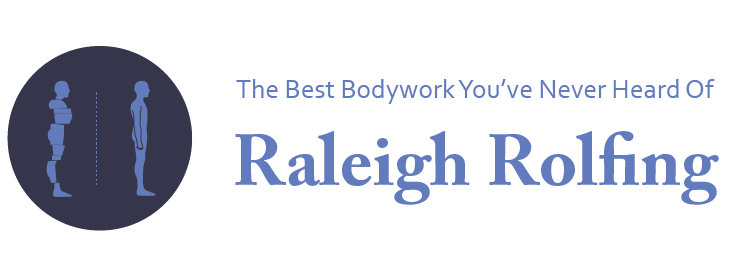What is Rolfing?
Rolfing® is a system of soft tissue manipulation and movement education that organizes the whole body in gravity. Rolfing affects the body's posture and structure by manipulating the myofascial system (connective tissue). Research has demonstrated that Rolfing creates more efficient muscle use, allows the body to conserve energy, and creates more economical and refined patterns of movement.
How do you pronounce it?
Like "golf" but with an r instead of g.
Where did the name and practice come from?
Rolfing is named after its creator, Dr. Ida P. Rolf, who originally referred to the work as Structural Integration. Read more about Dr. Rolf on our main rolfing introduction page.
Is Rolfing covered by insurance?
While not typically covered by insurance in North Carolina, Rolfing is usually covered by HSA(Health Savings Account) and FSA(Flexible Spending Account) plans although depending on your plan you may need a doctor's note for it.
Rolfing is typically reported to insurance with treatment code CPT 97140. If you wish to see if your insurance will cover Rolfing, ask them about coverage for this code.
If your insurance does cover Rolfing, I am happy to provide invoices for your use in filing insurance claims but I do not have the resources to file claims for clients.
How much does it cost?
Click the link to access Pricing information.
Does it hurt?/I've heard it hurts
The short answer is that it may at times, but it doesn't have to. And any moments of pain or discomfort are generally brief and well worth the long-term relief they provide.
The sensation of the work can vary from pleasurable to discomfort. In most cases, clients describe the worst as being like the discomfort of a very deep stretch or a "hurts so good" that most clients describe as something their body wants/needs. Most clients are coming to Rolfing on account of some sort of ongoing pain though and find that the relief afterwards to be well worth the temporary discomfort.
The idea that Rolfing is excruciatingly painful is an image of the work that has persisted from the early days of Rolfing back in the 60's and 70's. Over time the philosophy has changed and grown a great deal.
At all times though, you are in control and the work and level of pressure will be tailored to your needs and tolerances. I feel that Rolfing is much more effective when done within a client's tolerances.
For a little more information on this, you can read the blog post Jason wrote years ago about the relationship between Rolfing and pain.
This sounds weird/scary
This is a fairly typical reaction to something unfamiliar. Most people find that with a little courage and willingness to try it, the idea of Rolfing becomes a lot less scary. For those who are apprehensive, I am happy to schedule a consultation for you to try out the work and see if it fits for you.
Do I really have to do 10 sessions?
No, it is not necessary to do 10 sessions, however, if you are coming to Rolfing for any sort of chronic issue, it is highly recommended that you do a full ten-series if you find the work helpful.
What is fascia?
Fascia is the soft tissue component of the body's connective tissue system. Fascia is a fluid matrix tissue which wraps all of the muscles and visceral organs of the body. It also becomes the tendons and ligaments, attaching muscle to bone and supporting the organs.
Click here to see a youtube video about fascia and why it is important to your body
How is Rolfing different from massage?
Rolfing's primary aim is structural change through manipulation of connective tissue (fascia) while massage focuses on relaxation through muscle tissue. Rolfing is also structurally oriented, aiming to fix deeper causes of discomfort, where most massage styles do not have the structural component to them.
If you think of your body like a car, Rolfing is like rebuilding the transmission or replacing an engine where massage is more like an oil and filter change. Both are good aspects of maintenance, but they are different and require different skill sets.
How is Rolfing different from chiropractic?
Rolfing and chiropractic work have similar goals of better health through improved alignment but have some key differences in methodology. While chiropractic focuses on skeletal alignment and uilizes high velocity adjustments, Rolfing works for the structure through the connective tissue and primarily uses a very slow and steady touch to shift structure.
Rolfing and chirporactic care can be very complimentary therapies much like some chiropractors employ massage therapists. By freeing the connective tissue patterns around the bones, Rolfing can allow chiropractic adjustments to set much better and require less force to achieve.
How does Rolfing relate to psychotherapy and emotions?

The idea of a mind-body connection suggests that the body and the mind are interrelated rather than completely separate entities. Changes in the brain, intellectually or emotionally affect the body, and vice versa. We all see this intuitively on some level when we say someone "looks tired" or "seems sad." In practice, this does not mean that Rolfing directly attempts to influence thoughts or emotions. However, some clients may experience emotional release after a session in the sense of feeling lighter or feeling as if they can relate to the world or themselves in a new way.
What should I wear?
Either wear underwear that you are comfortable working in or a bathing suit. For women, a regular bra is preferable to a sports bra as it will cover less of your back. For men, briefs or boxer briefs are preferable, if you wear boxers please make sure they button in the front. For more information, see our New Clients information page.
